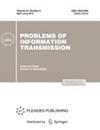超椭圆曲线上的仿射变异码
IF 0.9
4区 计算机科学
Q4 COMPUTER SCIENCE, THEORY & METHODS
引用次数: 1
摘要
我们估计了从超椭圆曲线上定义的初级单次仿射变异码的最小距离 \({x^5} + x - {y^2}\) 结束 \(\mathbb{F}_7\). 为了估计码的最小距离,我们应用符号计算实现Geil和Özbudak提出的技术。对于其中的一些码,我们也得到了符号对距离。进一步给出了构造码的广义汉明权值的下界。所提出的广义汉明权值的计算方法适用于任何原生单仿射变码。本文章由计算机程序翻译,如有差异,请以英文原文为准。
Affine Variety Codes over a Hyperelliptic Curve
We estimate the minimum distance of primary monomial affine variety codes defined from a hyperelliptic curve \({x^5} + x - {y^2}\) over \(\mathbb{F}_7\). To estimate the minimum distance of the codes, we apply symbolic computations implementing the techniques suggested by Geil and Özbudak. For some of these codes, we also obtain the symbol-pair distance. Furthermore, lower bounds on the generalized Hamming weights of the constructed codes are obtained. The proposed method to calculate the generalized Hamming weights can be applied to any primary monomial affine variety codes.
求助全文
通过发布文献求助,成功后即可免费获取论文全文。
去求助
来源期刊

Problems of Information Transmission
工程技术-计算机:理论方法
CiteScore
2.00
自引率
25.00%
发文量
10
审稿时长
>12 weeks
期刊介绍:
Problems of Information Transmission is of interest to researcher in all fields concerned with the research and development of communication systems. This quarterly journal features coverage of statistical information theory; coding theory and techniques; noisy channels; error detection and correction; signal detection, extraction, and analysis; analysis of communication networks; optimal processing and routing; the theory of random processes; and bionics.
 求助内容:
求助内容: 应助结果提醒方式:
应助结果提醒方式:


